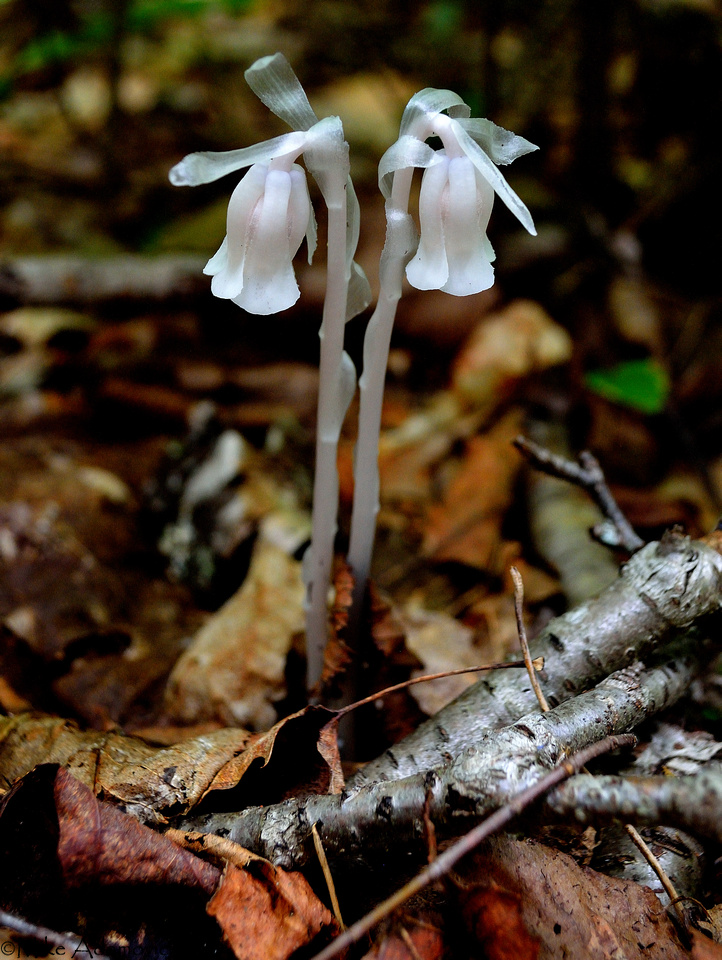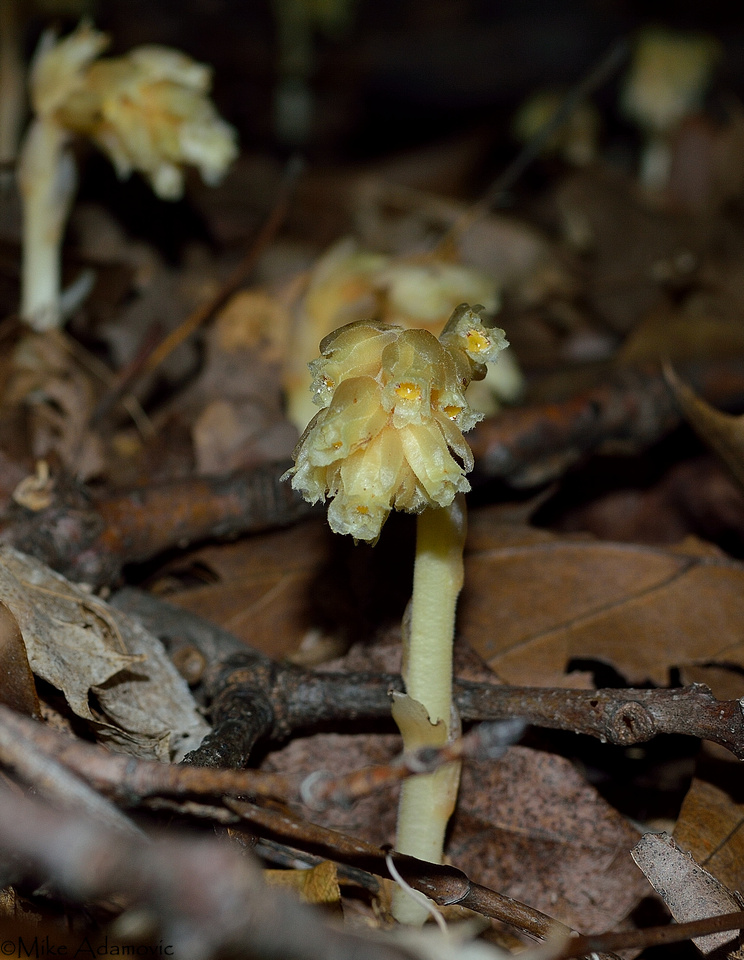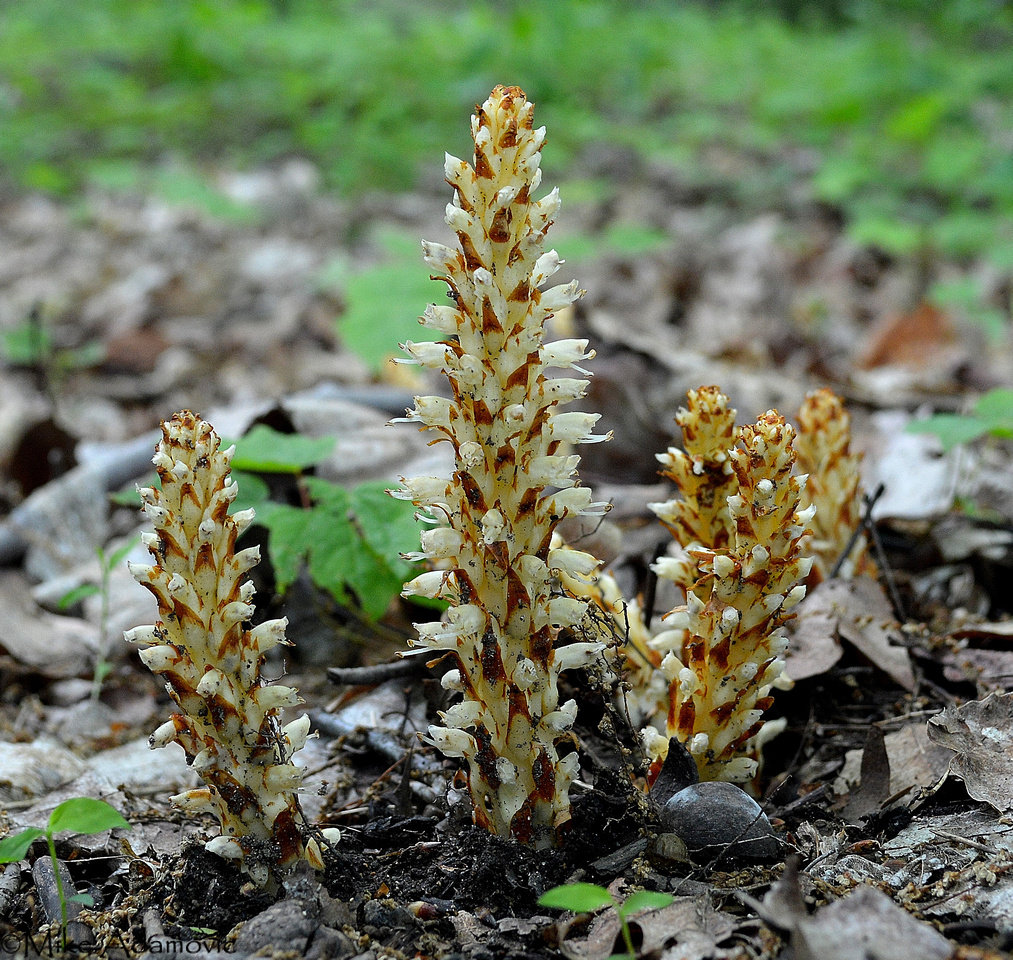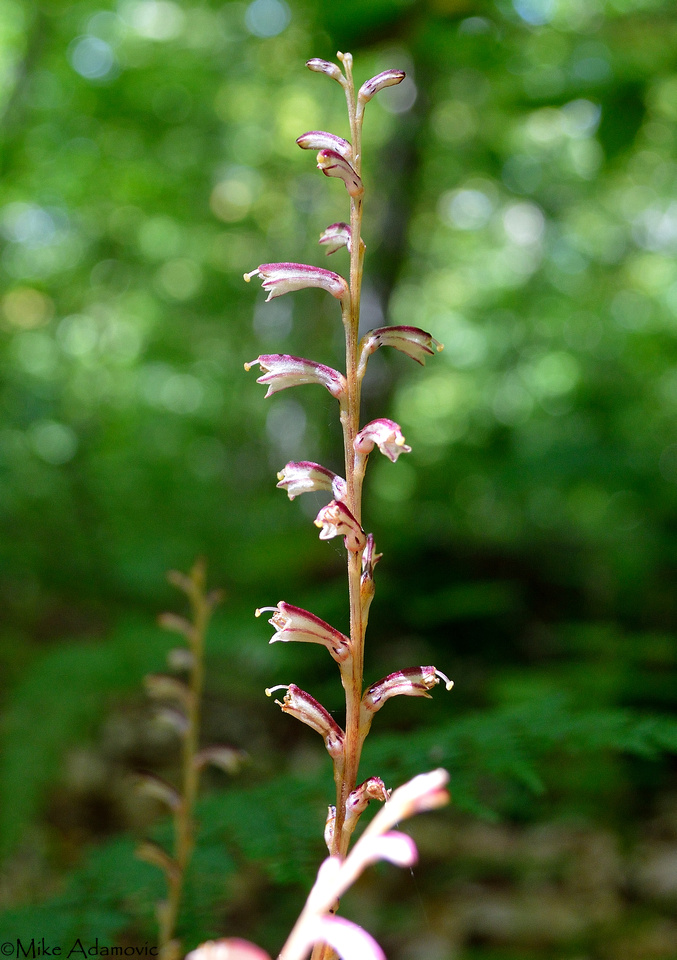Parasitic Plants
All plants, we are led to believe, are supposed to be sun-loving and infused with a robust quantity of chlorophyll. Self-sufficient and cloaked in a vigorous green that gives the forests and fields the majestic verdancy that we're accustomed to, it's hard to imagine a plant departing from this standard model and still residing in the plant kingdom. Yet, there is a curious group of plants that do just that. Lacking most attributes of their leafy brethren, they superficially resemble fungi more than anything else due to their parasitic ways. Since these individuals steal food rather than by making their own, they have no need for leaves or the the sugar producing and green pigmenting chlorophyll. Pallid and leafless features are therefore routine.
Bunches of Indian pipe, one of the most frequently encountered species, when first beginning to push their way up from the leaves of the forest understory from June to August look like the curled fingers of a body poking out of the soil. If the ghostly white flowers are plucked, they soon devolve into a gelatinous, jet-black mess. It's from these unsettling attributes that this plant has also been nicknamed the corpse flower. Fully erect and mature flowers are quite elegant, however; graced with fine scale-like leaves on the stem that stick out like the feathers of a peacock.
It's easy to see how this species received its more common moniker, looking like an old-fashioned kaolin clay pipe. While these "pipes" are curved down towards the ground initially, successfully pollinated flowers eventually straighten out and point skyward as the seed pods develop. The dried remains of blackened flowers are long lasting and frequently haunt the woods for some time, often remaining erect for a year or more in tight clusters.
The withered remains of beechdrops, a parasite of beech trees as the name suggests, possess a similar, if not more prolonged durability.


Indian pipe sustains itself by tapping into an underground network of thread-like roots of a mycorrhizal fungus, known as a mycelium, that is itself bound to the roots of a tree. The fungus and the tree have a mutualistic relationship, where each receives something from the other. The tree gets crucial nutrients, while its fungal partner is gifted with sugars produced by the autotroph. But unlike this beneficial arrangement, Indian pipe siphons away sugars and nutrients from the fungus—and indirectly the tree—without giving anything back in return.
Native Americans believed Indian pipe to be a remedy for sore eyes. Referring to dried plants, an early American pharmacopoeia listed it as an "excellent substitute for opium."
Pinesap, a close relative of Indian pipe, obtains its resources in a near identical manner. It falls into the genus Hypopitys, which translates to "under the pines," giving an indication where this species is commonly encountered. But it's by no means restricted to areas beneath evergreens. I've seen populations thriving under oaks, close to Indian pipes and other plant parasites, without a pine in sight. Despite its exceedingly widespread range, which encompasses a majority of the North American continent, pinesap is rare to find.


Unlike its ghostly cousin which produces only a single flower, pinesap boasts an infloresence of up to a dozen flowers haphazardly, even messily, clustered near the top of its stem that bear at least a modicum of color. There are two color morphs: pale golden yellow and light to vibrant red, which to some are considered distinct species. The yellow form appears to be more common and generally blossoms from June to early July; the red variety from late August to October.


Perhaps one of the most ecologically important parasitic plants out there is the truly bizarre looking squawroot. Having an appearance of a pinecone or a half eaten, decaying corn cob, squawroot definitely wins no awards in the beauty department, but it does possess an important talent. Its contribution as a food source to hungry wildlife cannot be overstated. Up to 10% of a black bear's diet is made up of this plant. Being high in fiber, it plays an especially helpful role in the spring to bears recently awakened from hibernation by getting their sluggish intestinal tract running properly again. It's also a favorite of white-tailed deer, and may be foraged upon by mice, chipmunks, and squirrels. Seed dispersal is needless to say largely mammalian in nature, with seeds getting transported to new locales via the gut of these creatures. The abundance of squawroot is directly correlated with wildlife populations—as it also is with the presence of certain tree species.



 Dispersed seeds need to find the right tree for successful germination. Squawroot is a parasite of oaks and the occasional beech and is more likely to be encountered in older forests. Plants have a lifespan of around a decade. For the first four years of its life an individual will remain below ground, developing a thick root that wraps itself around a host tree. Indian women, or "squaws," are said to have used the stalk and root of this plant to facilitate childbirth, induce menstrual bleeding, and alleviate the symptoms of menopause.
Dispersed seeds need to find the right tree for successful germination. Squawroot is a parasite of oaks and the occasional beech and is more likely to be encountered in older forests. Plants have a lifespan of around a decade. For the first four years of its life an individual will remain below ground, developing a thick root that wraps itself around a host tree. Indian women, or "squaws," are said to have used the stalk and root of this plant to facilitate childbirth, induce menstrual bleeding, and alleviate the symptoms of menopause.
Anyone passing through a grove of American beech trees from August to October should be on the look-out for the purple and white striped flowers of the beechdrops. This species is one of the most colorful and decorative of our root parasites. Numerous tubular flowers are borne along thin, wiry stalks. Each plant may issue multiple stalks emanating from a central root base, making the cluster in some cases resemble a small, leafless shrub. These plants, like many parasitic plants, steal nutrients—in this case from a beech tree—by inserting their haustoria, or modified roots, into the roots of a host. Beechdrops do little damage to trees even though they may severely wrap around and constrict a host's roots. The reason for this is simple: as annuals, beechdrops die at the conclusion of the growing season releasing the tree from its grip. Beechdrops are obvious among the forest understory, growing up to a foot and a half tall. While these grow wherever beech trees are present, they are especially prevalent in the northern half of the Northeast where beeches constitute a significant portion of the forest community.


Numerous other parasitic plants abound. Some, like the various dodder and mistletoe species have severed their connection with the ground. The stringy and messy dodders can be seen draped over the tops of their hosts, looking as if someone tossed a heap of spaghetti carelessly about. After climbing up herbaceous vegetation or low shrubs in vine-like fashion and tapping into a plant's vascular system, its below ground roots disappear. The sickly-hued yellow-orange dodders then feverishly engulf all surrounding vegetation, indiscriminately spreading from plant to plant in areas of dense growth.
Dwarf mistletoe, on the other hand, perhaps the most harmful of the plant parasites, is bolted to the upper branches of evergreens. This species is particularly damaging to black spruce in the northern reaches of the region and may actually result in the death of infested trees. Before succumbing, trees often develop a structure known as a "witches broom," a lush and bushy patch of branches on an increasingly spindly looking tree. This is where the parasites can be found. Sugars and nutrients that normally flow uninterrupted throughout the entirety of the tree are selfishly redirected here by the mistletoe. Explosive seed pods can expel seeds upwards of 50 feet away. Landing in the branches of nearby trees, seeds withstand being shaken, blown, and washed away by being coated in a sticky and viscous material that literally glues them to their new host.
Even the revered orchids sometimes engage in parasitism. Those from the genus Corallorhiza, the coralroots, make a living similarly to Indian pipe and pinesap. The demure autumn coralroot which blends in among the newly fallen leaves is perhaps the best representative of a parasitic orchid. In contrast, the yellowish-green early coralroot, which blooms in spring, produces moderate quantities of chlorophyll and is known as a hemiparasite, as it both photosynthesizes and steals resources.
Despite the negative connotation of parasites, these plants play a vital role in the health of an ecosystem. The most obvious and flower-like among them distribute resources to a broad array of creatures like a forest Robin Hood. The nectar of beechdrops, the protein-rich pollen of Indian pipes, and the starchy corn cob-like fruiting structures of squawroot provide insects and other wildlife with resources that would ordinarily become the leaves and woody tissue of trees, transforming an inaccessible food source into one readily available. All parasitic plants play their part, even when it comes to the insidious dwarf mistletoe. Forest gaps resulting from the die-off of black spruce and other evergreens by the parasite enable additional species to gain a foothold, while also allowing a new generation of trees to arise, so that the forest is comprised of individuals of all ages—the very the foundation of a healthy climax community.
Comments
我们深知您的隐私和安全至关重要,因此采用严格的保密措施,确保您的个人信息绝对安全。我们的服务不仅高效,而且灵活,能够根据您的具体需求进行定制,让您在忙碌的生活中仍能取得优异的学术成绩。
Jeff
http://www.printradiant.com | http://www.printlinkage.com | http://www.hitsticker.com | http://www.stickermac.com